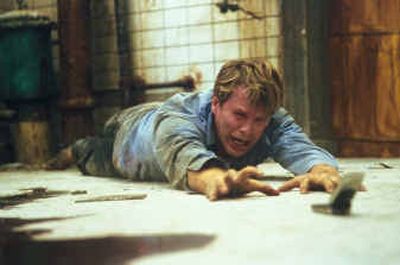Scared straight to the box office

In a nervous world, it’s natural to think that moviegoers would want to be coddled – not throttled – by what they watch. No sudden jolts, no big booms, no acts of graphic violence. Not when the headlines are so full of woe.
But the truth is, a grisly fright or a shocking sight can serve as a release valve from life’s pressures for those who prefer their cinema extreme rather than safe.
And Hollywood is taking note – especially when such offerings as last year’s R-rated remake of “The Texas Chainsaw Massacre” hacked its way to $80 million-plus at the box office.
“People go to movies to feel something,” says Brad Fuller, a co-producer on “Chainsaw” and next April’s new version of “The Amityville Horror.” “These films are really about running for your life. What is a more base emotion than that?”
A reliable indicator of how low audiences are willing to go arrived Friday, just in time for Halloween: “Saw.”
Distributor Lions Gate, which scored with such gore-gushers as “Cabin Fever “and “House of 1,000 Corpses,” had enough confidence in the warped brainchild of two 27-year-old Aussie horror freaks that it released the boundary-pushing thriller on 2,200 screens.
“Saw” drags the smarter-than-thou serial killer premise of “Seven” and “The Silence of the Lambs” to more stomach-churning depths.
Jigsaw, the unseen fiend, likes to watch as he forces his victims to play deadly games that often lead to a gruesome demise. A young woman awakens to find a large metallic trap wrapped around her jaw. Her face will explode if she doesn’t find the key to unlock it – which happens to be hidden inside the stomach of a not-quite-dead body.
Once the trailer showcasing the sickening sequence hit the Web, the resulting buzz was like a siren song for those hankering for nerve-wrackers beyond such tired money grabs as “Freddy vs. Jason.”
“I definitely love to be scared,” says “Saw” director James Wan. “It draws the primal side out of you.”
Or as screenwriter Leigh Whannell, who also co-stars in “Saw,” puts it: “Humans are still violent animals, and you need to get that out. The killer has done a lot of the work for you by exorcising your subconscious for a while.”
Some cite “The Passion of the Christ” as an example of the new tolerance for extreme viewing.
While the religious saw it as an affirmation of their faith, young males who like a juicy splatter flick also were passionate about “The Passion.”
“It’s ‘El Topo’ revisited,” says midnight-movie expert Stuart Samuels, comparing Mel Gibson’s biblical bloodbath to the gross-out Western from 1970.
The fright-film trend also has resurrected the zombie genre with the “Resident Evil” movies, “28 Days Later,” this year’s remake of 1978’s “Dawn of the Dead” and “Shaun of the Dead,” a British import that daringly mixes satirical gags with blood-soaked innards.
Even the godfather of all things ghoul, George Romero of “Night of the Living Dead” infamy, is directing the flesh-eating hordes again in a fourth chapter of his zombie series, “Land of the Dead,” due next year.
“The mainstream pictures that promise an intense experience are overperforming,” says Universal vice chairman Marc Shmuger. ” ‘Texas Chainsaw,’ ‘Dawn,’ ‘Kill Bill,’ ‘The Passion’ – they effectively cut through the noise of a cluttered media landscape.”
And despite the common thinking that young males are drawn to horror, Shmuger reports that such movies are becoming a favorite of the date crowd: “They can jump in each other’s laps, scream out loud and hold hands. It’s the perfect date experience.”
The trend does carry emotional ramifications. A sick kick that sticks in the psyche can lead to a lifetime of nightmares, warns mass media expert Joanne Cantor, author of the children’s book “Teddy’s TV Troubles” (Goblin Fern Press, 2004).
“If you are scared about something, seeing a movie that confronts this at a level that is not overwhelming and shows a resolution can be comforting,” she says.
“But that isn’t usually what you get. Most research shows that people feel even more frightened and experience more insomnia after a scary movie. If you saw ‘Jaws’ before the age of 10, you might never want to swim in the ocean again.”
That doesn’t mean extreme cinema will halt anytime soon.
“There is a certain tradition here,” says film critic Roger Ebert. “The French phrase ‘epater les bourgeois’ – ‘shock the middle class’ – describes what the surrealists were trying to do in the 1920s, and there will always be artists who find audiences for epatering.”